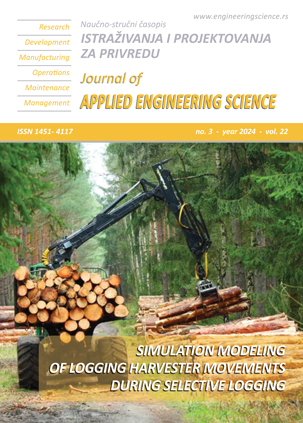INTELLIGENT RADIOACTIVE WASTE INACTIVATION AUTOMATION SYSTEM
Abstract
The paper deals with the implementation of an intelligent automation system that ensures the smooth operation of a radioactive waste inactivation system as well as the SCADA system responsible for monitoring the entire automation system. It includes the inspection of five radioactive waste management tanks and a central radioactive waste collection pit of a Nuclear Medicine laboratory. The purpose was to create an intelligent automation system with PLC with the possibility of the future expansion of the reservoirs after an increase in hospitalized patients. Object-oriented programming was used with modern control code development techniques, but also visualization of all necessary information. The states tested for system operation are Collection, Treatment, and Wastewater Waiting. Each of the 5 collection tanks has a level sensor, safety float, sewage agitation system, sewage inlet and outlet valves, wash valve, and sampling valve. The system has a central valve that directs wastewater from patient rooms receiving radioactive iodine treatment either to the quench tank system via a central sump or to the central sewer system. Active sewage is collected in the central well and pumped to the collection tank. The central well has a level sensor to activate the pumps and a safety float.
References
Rifkin (2011), The Third Industrial Revolution, P.Macmillan,
Margonis C. (2018), Management of radioactive waste in a hospital environment, Patras.
Arsos G., Gotzamanis-Psarrakou A., Karatsanis K.G, Karatzas N.D. (2003), Nuclear Medicine, Ziti Publications
Anninos F.A (2010), Medical Physics and Radiophysics, Parisianou S.A..
Sangrok K., Taeyoon K and Hyungjin Y. (2022), Design of a Low-Resolution Gamma-ray Spectrometer for Monitoring Radioactive Levels of Wastewater, Applied Science, vol. 5613, no. https://doi.org/10.3390/, p. 11.
Bolisetty S., Coray N., Palika A., Prenosilc G. and Mezzenga R. (2020), Amyloid hybrid membranes for removal of clinical and nuclear radioactive wastewater, Environmental Science Water Research & Technology, vol. 6, no. DOI: 10.1039/d0ew00693a, pp. 3249-3254
Leea S., Kima Y., Parkc J, Shond H.K., Honga S. (2018), Treatment of medical radioactive liquid waste using Forward Osmosis (FO) membrane process, Journal of Membrane Science, vol. 556, no. https://doi.org/10.1016/j.memsci.2018.04.008, pp. 238-247.
Wansha L., Kunning S. and Jingzhe L. (2021). Design and research on the construction of an intelligent biosafety management system for nucleic acid laboratories [J]. Electronic Journal of Emerging Infectious Diseases, 6(4): 352-355.
Petruzella F.D. (2018), Programmable Logic Controllers, Tziolas,.
J. Nemcik, F. Krupa, Z. Slanina, S. Ozana, J. Koziorek and D. Polak, (2020) Autonomous distributed control system strategy of rail vehicle for nuclear waste disposal, 20th International Conference on Control, Automation and Systems (ICCAS), Busan, Korea (South), pp. 906-911, doi: 10.23919/ICCAS50221.2020.9268242.
Samudro Μ., & Setiawan Α. (2020) Study of the use the internet of things (IOT) on ion exchange equipment as a long-term control and monitoring in the processing of liquid radioactive waste. In Sugianto (Ed.). Presentation Forum on Results and Activities of the Radioactive Waste Technology Center (PLTR) in 2019, (p. 288). Indonesia: Center for Radioactive Waste Technology, National Nuclear Energy Agency.

